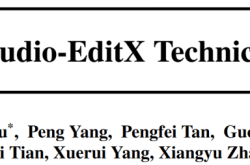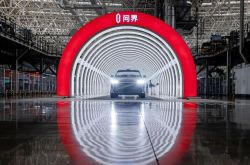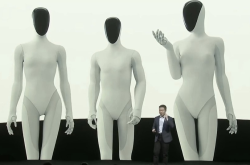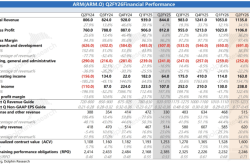DJI Re-Acquires Land in Shenzhen Amid Founder Wang Tao's Wealth Decline
![]() 12/30 2024
12/30 2024
![]() 466
466

Produced by Hongtu Finance, Written by Mo Enmeng, Edited by Shenhai
DJI, the financial powerhouse in the drone industry, is once again poised to acquire land in Shenzhen.
Recently, the Shenzhen Municipal Government's official website announced the "Selection Plan for the Global Headquarters Project of the Smart Aviation System Industrial Ecosystem." The document reveals that Shenzhen DJI Innovation Technology Co., Ltd. intends to acquire Plot DU01-02, located in the Shenzhen Bay Super Headquarters Base, with a land area of 15,658 square meters and an initial construction scale of approximately 188,000 square meters.
In fact, this isn't the first time DJI has ventured into land acquisition in Shenzhen. As early as 2016, DJI purchased a plot in Liuxian Cave, Nanshan District, for 710 million yuan, constructing its iconic "Sky City" headquarters there. Then, in 2019, DJI's holding company, Shenzhen DJI Osmo Technology Co., Ltd., acquired an industrial plot in Guangming District for 270 million yuan.
Reflecting on DJI's growth journey, from a modest office space in a residential building in Shenzhen to becoming a global leader in the drone industry, this achievement is attributed to the leadership of the team centered around founder Wang Tao. Alongside the company's rapid expansion, several individuals, including Wang Tao, have joined the ranks of billionaires.
However, according to the 2024 "Hurun Global Unicorn Index" and "Hurun China Rich List" released by Hurun Research Institute, both DJI's valuation and the wealth of individuals like Wang Tao have declined. Specifically, DJI's valuation dropped from 125 billion yuan last year to 80 billion yuan, while Wang Tao's wealth decreased from 50 billion yuan to 35 billion yuan.
Additionally, DJI has faced numerous challenges in recent years. Internally, the company has dealt with corruption issues. Externally, DJI navigates a complex geopolitical landscape. With the drone market gradually becoming saturated, DJI's revenue growth is also reaching its peak. To address these challenges, DJI has actively expanded its business areas, introducing products such as action cameras and gimbals. Recently, rumors suggest DJI may enter the robot vacuum cleaner market, further diversifying its product line.
DJI has acquired land in the Shenzhen Bay Super Headquarters Base, marking its third land acquisition in Shenzhen.
On December 25, the Shenzhen Municipal Government's official website released an announcement titled "Selection Plan for the Global Headquarters Project of the Smart Aviation System Industrial Ecosystem." The announcement revealed that Shenzhen DJI Innovation Technology Co., Ltd. plans to acquire Plot DU01-02 located in the Shenzhen Bay Super Headquarters Base.
This project's land use is classified as commercial service land with a land transfer period of 30 years. The plot covers a total land area of approximately 15,658 square meters and a total construction area of approximately 188,000 square meters (subject to the land transfer contract).
This includes a ground construction area of 184,100 square meters, divided into 172,344 square meters for offices, 2,000 square meters for commercial use, 9,400 square meters for cultural purposes, and 356 square meters for other uses, with an underground commercial construction area of 3,900 square meters.
To acquire this project land, DJI must make several commitments. For instance, within seven years from the date of applying for the headquarters project selection, from 2024 to 2030, DJI promises to accumulate an industrial output value of no less than 196 billion yuan and a service industry revenue of no less than 84 billion yuan in Shenzhen statistics, ensuring no less than 3.265 billion yuan is contributed to local finances in Shenzhen.
Furthermore, DJI pledges that within the full land transfer period, if a newly established enterprise in China has a paid-in registered capital exceeding 30 million yuan, it will prioritize establishing its registration and statistical relationship in Shenzhen and actively assist in attracting high-quality enterprises from upstream and downstream of the industrial chain.
Additionally, acquiring this project land comes with certain rights restrictions. After the headquarters project is completed, 100% of the building area cannot be transferred during the entire land transfer period. The office space can only be used by the intended land user and enterprises within the statistical scope of the industrial development supervision agreement.
Simultaneously, the intended land user cannot transfer the construction land use rights, buildings, structures, and ancillary facilities attached to the land in disguise through equity transfer or change during the entire land transfer period.
Radar Finance has compiled information and found that this isn't the first time DJI has acquired land in Shenzhen. In Nanshan District, Shenzhen, DJI has a headquarters base named "Sky City." In 2016, DJI purchased an industrial plot at the intersection of Xingke Road and Xiancha Road in the Liuxian Cave Headquarters Base, Nanshan District, for 710 million yuan.
Subsequently, DJI initiated the construction of its global headquarters there. Since its establishment over a decade ago, DJI has relocated several times, from its initial humble residential buildings to the Xili University Town Entrepreneurship Park, then to the Research and Development and Industrialization Building of the Hong Kong University of Science and Technology, and finally to Skyworth Semiconductor Design Building in Nanshan District...
As the number of employees grew, DJI's office space also expanded step by step. In September 2022, the six-year, 1.6 billion yuan "Sky City" project was officially completed and opened. At this point, DJI employees finally had a "home" of their own.
DJI's "Sky City" covers an area of 17,600 square meters and has a construction area of approximately 240,000 square meters. Designed by Foster + Partners and constructed by China State Construction Engineering Corporation Limited Fourth Engineering Division, the building complex consists of two super high-rise towers, the East Tower with 44 floors and a height of 211.6 meters, and the West Tower with 40 floors and a height of 193.1 meters. The two towers are connected by an "air bridge" at an elevation of 110 meters above ground.
In 2019, Shenzhen DJI Osmo Technology Co., Ltd. won a plot of land, A512-0091, located at the intersection of Guangqiao Road and No. 37 Road in Guangming District, with a starting price of 270 million yuan. The plot covers a total area of 29,078.81 square meters and a construction area of 116,315 square meters.
According to Tianyancha, Shenzhen DJI Osmo Technology Co., Ltd. is a holding company of Shenzhen DJI Innovation Technology Co., Ltd., directly holding 58.82% of the former's shares. The remaining 41.18% is held by Shanghai Feilai Information Technology Co., Ltd., whose sole shareholder is also Shenzhen DJI Innovation Technology Co., Ltd.
Drone Giant Emerging from Residential Buildings
Wang Tao, born in 1980 in Hangzhou, Zhejiang, harbored an endless curiosity and longing for the vast sky since childhood. Wang Tao has sincerely expressed his aspirations, "I can't turn into a bird, but drones can take photos or transmit videos from the air, which can replace my eyes and fulfill my desire to overlook the earth from the air while flying."
This fascination with the sky led him to immerse himself in aerospace literature, constantly absorbing knowledge. In his teens, after scoring well on an exam and winning praise from his parents, Wang Tao finally obtained his first remote-controlled helicopter.
However, upon receiving his longed-for reward, Wang Tao discovered that the helicopter's control was far less flexible than he had imagined and couldn't even hover stably. Instead of being discouraged, this discovery fueled his determination to build a helicopter that could fly autonomously and be manipulated flexibly.
After the college entrance examination, Wang Tao successfully enrolled at East China Normal University, majoring in electronics. However, in his junior year, Wang Tao withdrew from East China Normal University and applied to several top universities worldwide. Rejected by top universities like Stanford and MIT, he eventually found his stage at the Department of Electronic Engineering of the Hong Kong University of Science and Technology.
At the Hong Kong University of Science and Technology, Wang Tao not only acquired abundant professional knowledge but also met a group of like-minded partners and mentors. In 2005, while preparing for his graduation project at the Hong Kong University of Science and Technology, Wang Tao focused on the flight control system of remote-controlled helicopters. The core problem he aimed to solve was automatic hovering, but after more than half a year of effort, their demonstration failed.
However, Wang Tao's talent was recognized by Professor Li Zexiang, who recruited him as a graduate student. In 2006, with the support of his supervisor, Wang Tao gathered classmates who had worked on the graduation project and, with the 2 million Hong Kong dollars they raised, founded DJI in a residential building in Lianhua Beicun, Futian District, Shenzhen.
Like many entrepreneurs, Wang Tao's team experienced the hardships of startup life in this residential building. Many interviewees who came for job interviews even thought it was a shell company. Despite the numerous difficulties in the early stages, Wang Tao did not give up. Through unremitting efforts, DJI gradually emerged, launching several highly anticipated products.
In 2007, DJI released the helicopter flight control XP2.0. In the same year, DJI's flight control achieved its first beyond-visual-range flight, breaking the limitation of vision. Since then, DJI has continuously innovated and iterated, launching several groundbreaking drone products that have led industry trends.
In 2012, DJI successfully launched the world's first aerial photography all-in-one drone, the Phantom 1, marking DJI's strong rise in the drone industry. The following year, the release of the Phantom 2 Vision further consolidated DJI's position in the market. In 2019, DJI made another splash by releasing the Osmo Action camera, designed specifically for outdoor sports and video enthusiasts, which won recognition from many users...
After years of development, DJI has become a globally leading brand in the drone industry. DJI's continuous launch of new products has repeatedly amazed the industry. Statistics show that DJI holds more than 70% of the global consumer drone market due to its outstanding technological strength.
Founder's Wealth and Corporate Valuation Both Shrink, DJI Slows Down?
Although DJI is now a powerful player on the global tech stage and frequently acquires land in the expensive city of Shenzhen, it remains a private company. However, this doesn't diminish DJI's prominent position among global unicorn enterprises.
Radar Finance has compiled information and found that as early as 2019, when Hurun Research Institute first released the "Hurun Global Unicorn Index," DJI ranked 15th with a valuation of 100 billion yuan. By last year's "2023 Hurun Global Unicorn Index," DJI's valuation had soared to 125 billion yuan.
However, entering 2024, DJI's valuation has shrunk. Its valuation in the "2024 Hurun Global Unicorn Index" dropped to 80 billion yuan, a decrease of 45 billion yuan from the previous year, and its ranking slipped from 20th to 40th.
As a private company, DJI doesn't need to regularly disclose its financial performance to the public. According to some media outlets quoting DJI's 2018 financing materials, DJI's revenue grew from 5.98 billion yuan to 17.57 billion yuan from 2015 to 2017, and its net profit jumped from 1.42 billion yuan to 4.3 billion yuan. Furthermore, according to the 2023 Top 500 Chinese Private Enterprises list released by the All-China Federation of Industry and Commerce in September last year, DJI reported a revenue of 30.14 billion yuan in 2022.
From humble beginnings in a residential building office to becoming a giant in the drone industry, DJI has also successfully created several wealthy billionaires. In last year's "Hurun China Rich List," Wang Tao, Lu Di, and Xie Jia from DJI were listed with wealth of 50 billion yuan, 17 billion yuan, and 14.5 billion yuan, respectively.
However, in the recently released "2024 Hurun China Rich List," the wealth of the aforementioned individuals has declined compared to last year. Specifically, Wang Tao's wealth dropped to 35 billion yuan, a decrease of 15 billion yuan from the previous year. Lu Di and Xie Jia's wealth also shrank, falling by 5 billion yuan and 4.5 billion yuan to 12 billion yuan and 10 billion yuan, respectively.
It's undeniable that DJI has played a significant role in driving the transformation of the global consumer drone market. However, in recent years, DJI has also faced many severe challenges.
For example, in terms of internal management, DJI has been plagued by corruption issues, with many "parasites" emerging within the company. In January 2019, DJI issued an internal letter to all employees, publicly announcing the company's new round of anti-corruption "achievements." The internal announcement revealed that due to internal corruption in 2018, DJI estimated losses exceeding 1 billion yuan and disciplined 45 individuals suspected of corruption and malfeasance.
Externally, DJI also faces complex and ever-changing challenges.
More severely, DJI founder Wang Tao predicted in 2016 that the drone market was nearing saturation, and DJI's revenue might peak at 20 billion yuan. This implies that if DJI doesn't actively explore new business areas, its revenue will face a growth bottleneck, making it difficult to replicate its previous high-growth trends.
To address these challenges, DJI has continuously tried and strived to expand its business boundaries. Radar Finance has compiled information and found that in addition to its traditional drone product line, DJI has also launched products such as action cameras, gimbals, wireless microphones, and professional imaging equipment.
In addition to the aforementioned products, DJI is also aiming to make a foray into the robot vacuum cleaner market. The company aims to propel its continued growth through new categories, including robot vacuum cleaners. A report by LatePost indicates that DJI has been developing robot vacuum cleaners for the past four years and anticipates the launch of new products by mid-next year.
An insider from DJI disclosed that the decision to enter the robot vacuum cleaner market stems from the fact that the technology utilized in these products aligns seamlessly with DJI's extensive experience, encompassing path planning, visual recognition for obstacle avoidance, high-performance motors, and LiDAR. These technologies have been honed during the company's drone development process.
Nevertheless, in response to rumors regarding DJI's diversification into the robot vacuum cleaner market, the company told the media that its products are constantly being updated and optimized. To ensure accurate information is disseminated to users, DJI does not comment on unreleased products or associated rumors.
Radar Finance will continue to closely monitor any subsequent developments from DJI.








